Passenger Car CTP (Cell to Pack), CTC (Cell To Chassis) and CTB (Cell to Body) Integrated Battery Industry Report, 2024
Passenger Car CTP, CTC and CTB Integrated Battery Industry Report, 2024 released by ResearchInChina summarizes and studies the status quo of CTP (Cell to Pack), CTC (Cell To Chassis) and CTB (Cell to Body) for passenger cars and the layout of OEMs and suppliers in related products, and predicts the future development trends of passenger car integrated batteries.
1. In 2023, CTP (Cell to Pack) technology was seen in nearly 50% of new energy vehicles sold.
In 2021, there were only 13 vehicle models equipped with CTP in China. As of October 2023, the number had increased to 57. Vehicles equipped with CTP shared 29.6% of the total sales of new energy vehicles (EVs, PHEVs and EREVs) in 2021, and made up 48.6% from January to October 2023, a figure projected to be higher than 50% in the whole year of 2023.
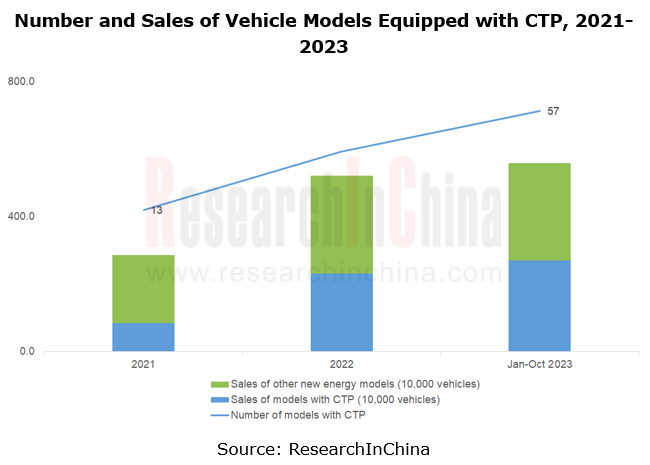
From the perspective of both suppliers and OEMs, CTP technology has entered a mature application stage.
Among suppliers, CATL is a role model. In 2019, CATL released its CTP 1.0. By 2023, the technology has iterated to 3.0, and has been installed by brands such as ZEEKR, Li Auto and AITO.
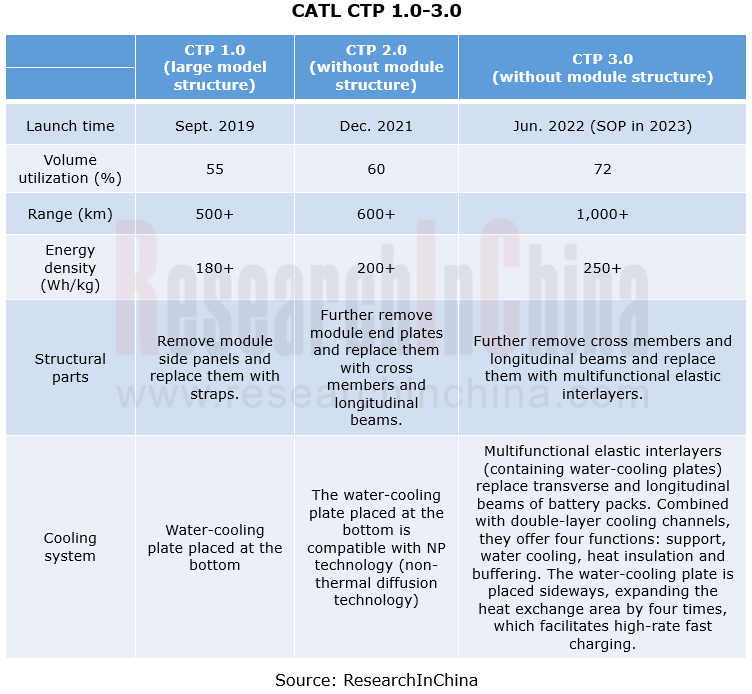
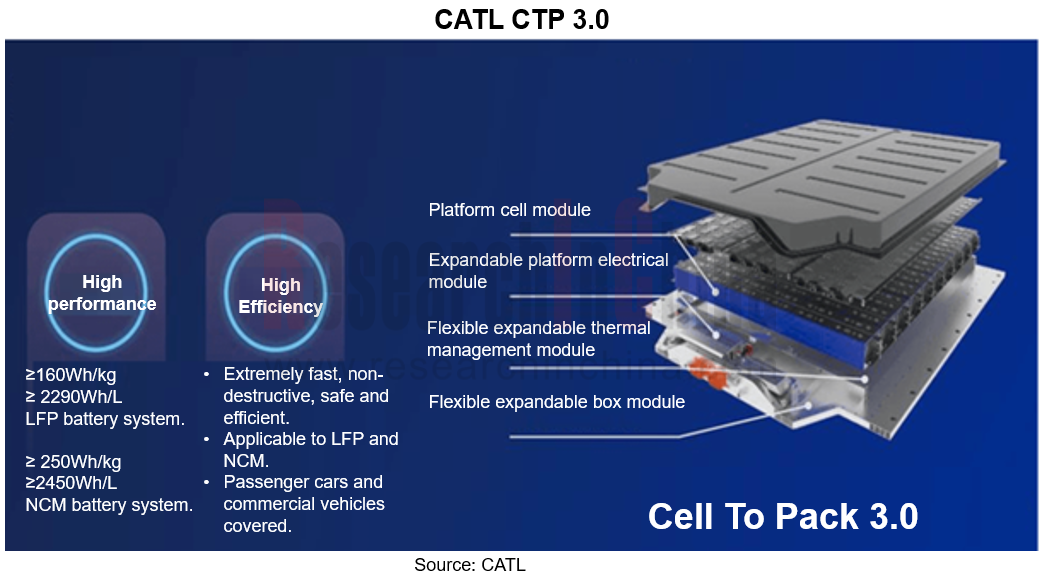
OEMs are represented by BYD. In 2020, BYD released its blade battery based on CTP technology, which was first mounted on Han EV in June of the same year. In 2023, with higher blade battery capacity, BYD began to supply batteries to other automakers after meeting its own demand. Both Tesla and Hongqi have some models equipped with the blade battery.
According to the statistics of ResearchInChina, there are more than 17 models using blade batteries. By the end of 2023, BYD had deployed 17 blade battery production bases with the planned capacity of over 460GWh.
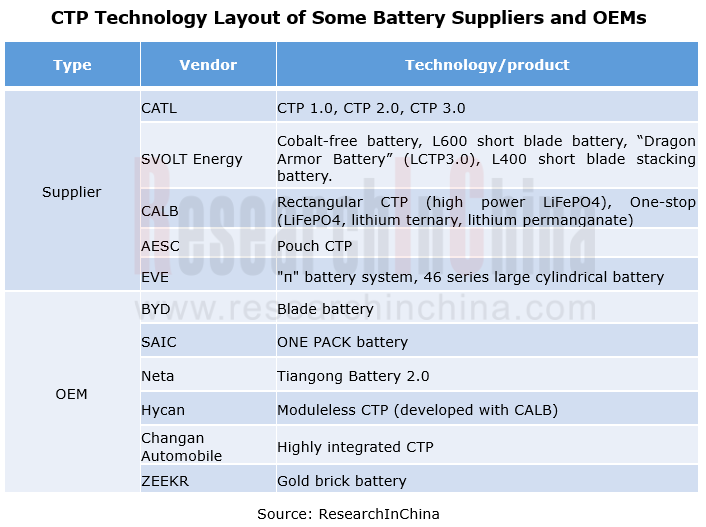
2. CTC/CTB technology is easier to implement under the leadership of OEMs
2.1 Currently only four automakers Tesla, BYD, Leapmotor and Xpeng have released CTC/CTB technology and applied it in production models.
① Tesla: In 2020, Tesla introduced the concept of CTC (Cell To Chassis) for the first time on its Battery Day, which cancels the floor of the vehicle body, integrates the battery frame with the underbody (rocker rail, transverse beam, longitudinal beam, floor, etc.), and then connects the castings at the front and rear ends of the body.
From the point of performance improvement, Tesla's CTC technology offers the benefits: a 10% reduction in vehicle weight, a 14% increase in cursing range, a reduction of 370 parts, 7% lower unit cost, 8% lower unit investment, and far higher automobile manufacturing efficiency. CTC technology has been applied to Model Y produced at Gigafactory Texas.
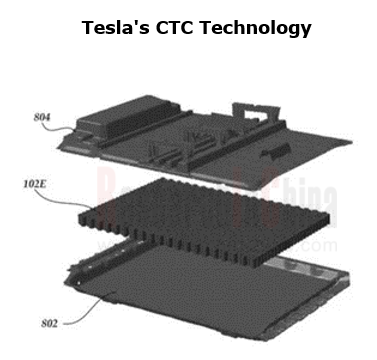
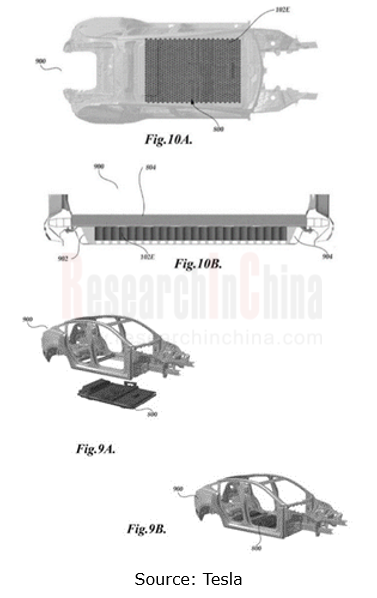
② Leapmotor: In April 2022 Leapmotor released CTC technology, and first applied it to the production model Leapmotor C01. Leapmotor’s CTC solution cancels the battery pack housing and upper cover, and retains the integrated battery module and lower battery tray.
Leapmotor’s CTC technology can increase the vertical space of the vehicle by 10mm, the battery layout space by 14.5%, the cursing range by 10% and the torsional stiffness of the body by 25% to 33897N·m/°, and reduce the number of parts by 20% and the weight by 15kg. CTC 2.0 unveiled by Leapmotor in 2023 enables 10% fewer parts and 5% less weight than CTC 1.0.
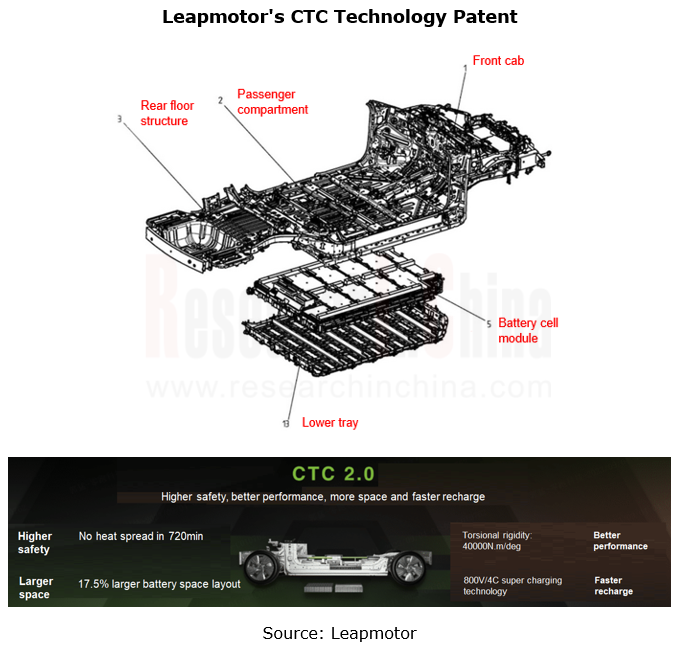
③ BYD: In May 2022, BYD released CTB (Cell to Body), a technology using the upper shell of the battery pack to replace the body floor. It cancels the modules and the upper shell of the battery pack, and sticks the blade battery to the tray and upper cover to form a sandwich structure of "battery upper cover-cell-tray".
The volume utilization rate of BYD’s CTB can be raised to 66%; the torsional stiffness of the vehicle body exceeds 40,000 N m/; the intrusion of the vehicle side column collision is reduced by 45%. The wind resistance of Seal, the first model equipped with CTB, is as low as 0.219, and the 0-100 km/h acceleration of the four-wheel drive edition only takes 3.8 seconds, with energy consumption per 100 kilometers as low as 12.7kWh.
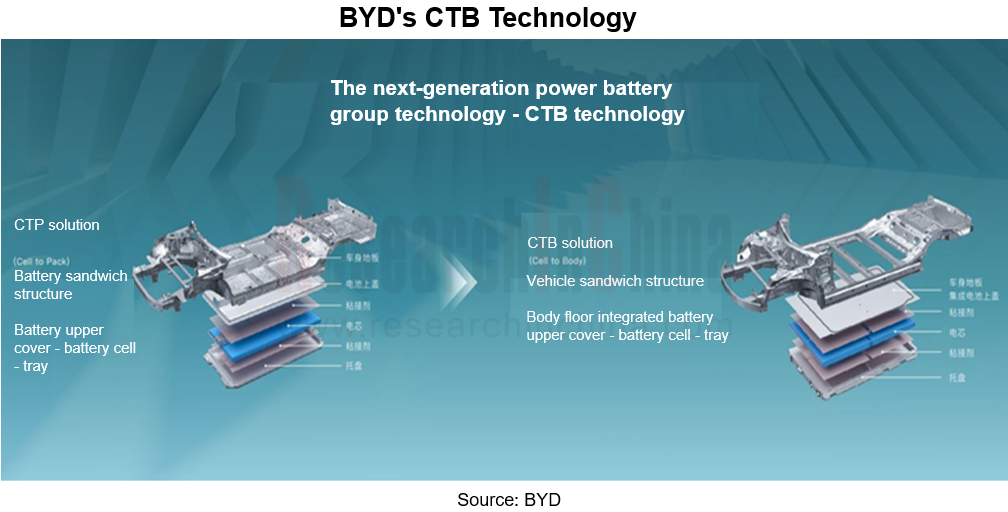
④ Xpeng: In April 2023, Xpeng launched its "Fuyao" architecture, which adopts CIB technology that uses the upper cover of the battery pack as the body floor, thereby saving 5% vertical interior space. As with Tesla, Xpeng integrates the reserved mounting bracket on the battery pack upper cover, and installs seats directly on the battery pack.
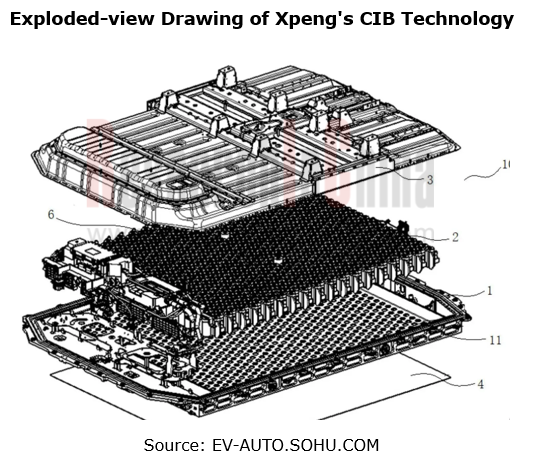
2.2 As per the technical features of CTC/CTB, OEMs cannot tolerate less say.
In the conventional new energy industry chain, power batteries account for 30%~40% of the vehicle cost. In the promotion process of CTC technology, the use of CTC makes it easier for battery vendors to dabble in chassis and vehicle development. For automakers, this may lead to less say, which is unacceptable to them.
CTC technology however requires battery cells with high intrinsic safety, and this needs to enhance thermal stability of battery cell materials. As concerns process, it is necessary to ensure the reliability of battery cells in terms of design and manufacturing. These are the advantages of battery vendors. Amid a combination of multiple factors, the model that OEMs play a leading role and suppliers cooperate with them may be the main way to advance CTC technology in the future.
In the case above OEMs that have the ability to develop and produce battery cells by themselves, such as BYD and Tesla, can effectively avoid the technical restrictions from battery vendors and have greater advantages in technology application.
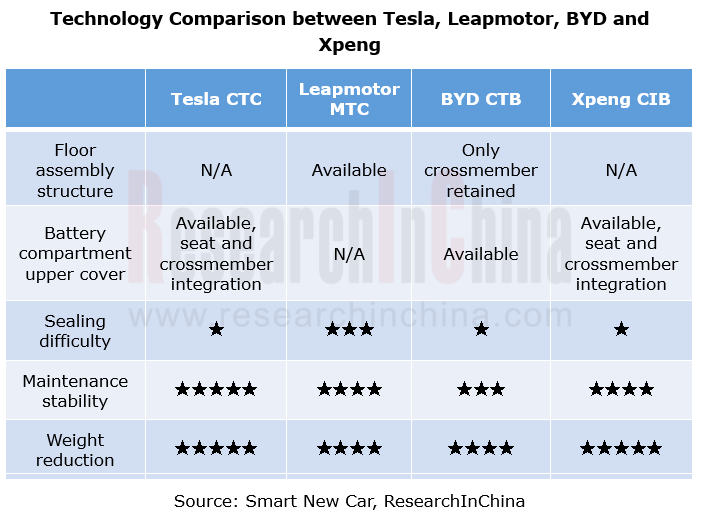
2.3 CTC technology layout of other OEMs
In addition to Tesla, BYD, Leapmotor and Xpeng, Xiaomi, Volkswagen, Volvo, JAC and SAIC all make layout of CTC technology. On December 28, 2023, Xiaomi unveiled SU7, a car that packs its self-developed CTB technology. The innovative designs such as floor-cover two-in-one, battery cell inversion, multifunctional elastic interlayer and minimalist wiring harness enable the volume efficiency up to 77.8% and release an additional height of 17 mm.
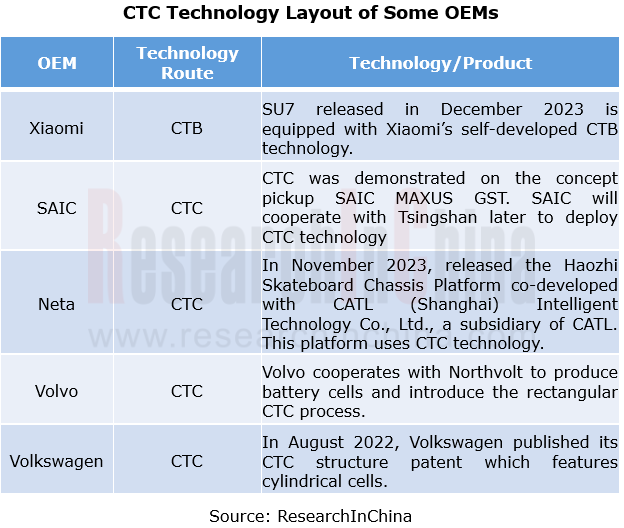
OEMs and Tier 1 Suppliers' Cost Reduction and Efficiency Enhancement Strategy Analysis Report, 2025
ResearchInChina released the "OEMs and Tier 1 Suppliers' Cost Reduction and Efficiency Enhancement Strategy Analysis Report, 2025", summarizing hundreds of cost reduction strategies to provide referen...
Automotive Fixed Panoramic Sunroof and Smart Roof Research Report, 2025
With the intelligent application of car roofs as the core, this report systematically sorts out a series of new products such as fixed panoramic sunroof/openable sunroof, ceiling screen, roof ambient ...
Automotive-Grade Power Semiconductor and Module (SiC, GaN) Industry Research Report, 2025
SiC/GaN Research: Sales volume of 800V+ architecture-based vehicles will increase more than 10 times, and hybrid carbon (SiC+IGBT) power modules are rapidly being deployed in vehicles.
Sales volume o...
Cockpit Agent Engineering Research Report, 2025
Cockpit Agent Engineering Research: Breakthrough from Digital AI to Physical AI
Cockpit Agent Engineering Research Report, 2025 starts with the status quo of cockpit agents, summarizes the technical ...
Prospective Study on L3 Intelligent Driving Technology of OEMs and Tier 1 Suppliers, 2025
L3 Research: The Window of Opportunity Has Arrived - Eight Trends in L3 Layout of OEMs and Tier 1 Suppliers
Through in-depth research on 15 OEMs (including 8 Chinese and 7 foreign OEMs) and 9 Tier 1 ...
China Commercial Vehicle IoV and Intelligent Cockpit Industry Research Report 2025
Commercial Vehicle IoV and Cockpit Research: The Third Wave of Passenger Car/Commercial Vehicle Technology Integration Arrives, and T-Box Integrates e-Call and 15.6-inch for Vehicles
I. The third wav...
Intelligent Vehicle Electronic and Electrical Architecture (EEA) and Technology Supply Chain Construction Strategy Research Report, 2025
E/E Architecture Research: 24 OEMs Deploy Innovative Products from Platform Architectures to Technical Selling Points
According to statistics from ResearchInChina, 802,000 passenger cars with domain...
Research Report on Intelligent Vehicle Cross-Domain Integration Strategies and Innovative Function Scenarios, 2025
Cross-Domain Integration Strategy Research: Automakers' Competition Extends to Cross-Domain Innovative Function Scenarios such as Cockpit-Driving, Powertrain, and Chassis
Cross-domain integration of ...
China Autonomous Driving Data Closed Loop Research Report, 2025
Data Closed-Loop Research: Synthetic Data Accounts for Over 50%, Full-process Automated Toolchain Gradually Implemented
Key Points:From 2023 to 2025, the proportion of synthetic data increased from 2...
Automotive Glass and Smart Glass Research Report, 2025
Automotive Glass Report: Dimmable Glass Offers Active Mode, Penetration Rate Expected to Reach 10% by 2030
ResearchInChina releases the Automotive Glass and Smart Glass Research Report, 2025. This r...
Passenger Car Brake-by-Wire (BBW) Research Report, 2025
Brake-by-Wire: EHB to Be Installed in 12 Million Vehicles in 2025
1. EHB Have Been Installed in over 10 Million Vehicles, A Figure to Hit 12 Million in 2025.
In 2024, the brake-by-wire, Electro-Hydr...
Autonomous Driving Domain Controller and Central Computing Unit (CCU) Industry Report, 2025
Research on Autonomous Driving Domain Controllers: Monthly Penetration Rate Exceeded 30% for the First Time, and 700T+ Ultrahigh-compute Domain Controller Products Are Rapidly Installed in Vehicles
L...
China Automotive Lighting and Ambient Lighting System Research Report, 2025
Automotive Lighting System Research: In 2025H1, Autonomous Driving System (ADS) Marker Lamps Saw an 11-Fold Year-on-Year Growth and the Installation Rate of Automotive LED Lighting Approached 90...
Ecological Domain and Automotive Hardware Expansion Research Report, 2025
ResearchInChina has released the Ecological Domain and Automotive Hardware Expansion Research Report, 2025, which delves into the application of various automotive extended hardware, supplier ecologic...
Automotive Seating Innovation Technology Trend Research Report, 2025
Automotive Seating Research: With Popularization of Comfort Functions, How to Properly "Stack Functions" for Seating?
This report studies the status quo of seating technologies and functions in aspe...
Research Report on Chinese Suppliers’ Overseas Layout of Intelligent Driving, 2025
Research on Overseas Layout of Intelligent Driving: There Are Multiple Challenges in Overseas Layout, and Light-Asset Cooperation with Foreign Suppliers Emerges as the Optimal Solution at Present
20...
High-Voltage Power Supply in New Energy Vehicle (BMS, BDU, Relay, Integrated Battery Box) Research Report, 2025
The high-voltage power supply system is a core component of new energy vehicles. The battery pack serves as the central energy source, with the capacity of power battery affecting the vehicle's range,...
Automotive Radio Frequency System-on-Chip (RF SoC) and Module Research Report, 2025
Automotive RF SoC Research: The Pace of Introducing "Nerve Endings" such as UWB, NTN Satellite Communication, NearLink, and WIFI into Intelligent Vehicles Quickens
RF SoC (Radio Frequency Syst...